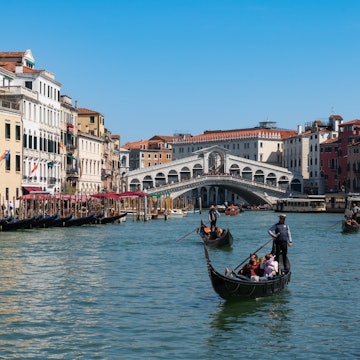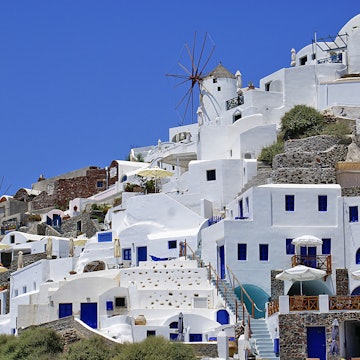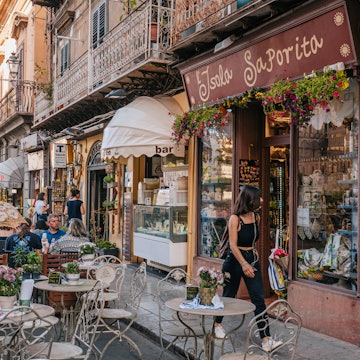

The Venetian harbor of Rethymno, Crete. Georgios Tsichlis/Shutterstock
You can spend as much or as little as you want in Crete. But overall, the island has a well-deserved reputation for being one of the most affordable in the Mediterranean. The island's large size, its myriad businesses vying for tourist euros and its popularity combine to keep prices competitive. Visitors reap the rewards on what is one of Europe's most rewarding destinations.
With some planning and shopping around, you can get good deals on transport and accommodation. Once there, buses provide affordable transport, while the most interesting towns and beaches are best explored on foot. If you need a car, there are ways to beat high rental prices.
Greece is not expensive, so when you eat and drink like a local, enjoying the excellent and much-vaunted Cretan produce and cuisine, whether at locally popular tavernas or in meals you prepare yourself, the savings are great. And if you still need more inspiration, most of the ornate and historic churches are free.
To help you budget for your visit to Crete, here's a guide to local prices along with some of our top budgeting tips.

Daily costs
Hostel bed: €15–20 (US$17–22)
Basic room for two: €45–60 (US$50–67)
Self-catering apartment: €60–150 (US$67–168)
Bus ticket: €2–15 (US$2.25–17)
Coffee: €2–4 (US$2.25–5)
Souvlaki sandwich: €6 (US$7)
Dinner for two: €40–100 or more (US$45–112)
Pint of Mythos beer at a cafe: €5 (US$5.60)
Serving of bougatsa (creamy Cretan pastry): €3 (US$3.40)
Beach umbrella and lounger rental: €10 (US$11.20)

1. Decide between the ferry and a plane to Crete
If you're coming to Crete from Athens, there are many fast ferries to Iraklio and Hania in summer. From November to April, there is at best one boat daily on these routes. The trips take 9 to 12 hours and tickets can cost under €50 (US$56) – more if you want a cabin for an overnight trip or if you're bringing a car.
Alternatively, it's possible to fly from Athens for under €100 (US$112). Which way you get to Crete will end up being a decision between cost and time. Ferries are less hassle than flying and some people enjoy lounging on deck and lingering over cafeteria-style meals.
Where ferries offer a real advantage is on trips between Crete and other islands. From late April through October, a network of routes – mostly from Iraklio – radiate out across the Aegean. You can be in Santorini (Thira) in as little as two hours and for less than €70 (US$78). Airfares for direct flights to other islands such as Rhodes are priced to reflect the convenience offered as opposed to luring in the punters.
2. Find a cheap flight
Neither of Crete's two airports at Iraklio and Hania is notably cheaper for flights than the other. Rather, decide which one works for you depending on where you're going on the island.
Iraklio does have more flights than Hania, especially ones from around Europe. Fares to Crete are cheapest in summer when options are many. But be sure to book as early as possible as flights fill up, particularly in July and August, the peak months for tourism. Conversely, the number of flights to the island plummets in winter, so don't expect to find bargains then.

3. Travel in shoulder season
Package deals for travel to Crete in the high season are priced to be competitive with other sunny resorts around the Mediterranean. But given the volume of travel in the summer, there are few real bargains.
The best time to save money on a trip to Crete is in the shoulder seasons, which is April to June, and September and October. During these months, the weather is warm and sunny and almost all tourism-related businesses like hotels are open. Yet with visitor numbers fewer than in July and August, prices are designed to lure people to the island. Shopping around for bargains during the shoulder season months can yield some real bargains.
4. Look beyond the obvious for accommodation savings
Crete has plenty of hotels and resorts with stunning ocean views, but you'll pay for the pleasure. In resort towns, look for apartments and small hotels back from the beach. That 10-minute walk can save you lots of euros every day. Popular towns like Hania and Rethymno have excellent hostels.
And consider off-beat destinations like villages back in the mountains such as Spili, where lovely, simple doubles can be had for €50 (US$56). Look for less-visited beaches and towns such as Falasarna, where hotel prices reflect the lack of hype. Scroll beyond the high-profile choices on sites like Airbnb and booking.com for small family-run accommodations. You'll not only be rewarded with cheaper prices but also a warmer welcome.
Note that because of the scorching heat and blazing sun during summer, camping is not a popular option in Crete (and in winter it's blustery, cold and rainy).

5. Ride the bus
From April to October, you can get to all the main areas of Crete using public buses. Two websites provide schedule and fare information: one is for western Crete, with service centered on the major city of Hania, while the other covers services in central and eastern Crete, with service centered on the capital of Iraklio.
On busy routes such as those linking the main cities of the north coast, there are frequent bus services year-round. Service into the mountains and to the more remote beaches can be infrequent, even in summer, so it's worth spending time checking schedules to plan out your journeys.
Buses are air-conditioned and most have free wi-fi – fares average about €10 (US$11.20) and you can often book seats in advance on longer routes.
6. Plot out your rental car strategy
Renting a car in Crete can be expensive, or it can be remarkably affordable with a little effort. First, shop in advance: look for package deals that include a rental car with accommodation. These sorts of offers can yield the best savings for your combined room and car budget if you want your own wheels for your entire visit. If booking your car separately, start your search as far in advance as possible. Last-minute deals are rare.
Consider sharing your rental car with as many people as you can fit in it. For instance, the bus fare from Hania to the magnificent beach at Elafonisi is €11 (US$12.30) each way. For four people, that's €88 (US$98) for a day's outing, which is more than the cost of a cheap rental.
Rent a car only on the days you really need it, such as when exploring mountain villages or touring Iraklio's wine region. Besides money, you'll save on the considerable hassle of parking in Crete. Ask at your accommodations for local sources of rental cars. You may find that the owner has a cousin ready to make a deal for a car that would otherwise sit empty for a day.

7. Get local recommendations on where to eat
The simplest way to find cheap and good eats? Ask a resident! People working low-paid summer jobs all need to eat and they are often happy to share their off-the-beaten-path souvlaki stands, scent-filled bakeries and budget tavernas.
No matter how popular and touristy a town, a quick jaunt down back alleys away from the waterfront or flower-bedecked squares can yield excellent options for a meal. Cretans relish a good meal, so when you go where they go, you'll eat and drink well.
8. Shop at the market and self-cater
Every town has a market – often daily – where Crete's superb produce and prepared foods are sold. This is the best way to enjoy the island's famous local foods (even the olive oil is divine) and just browsing the stalls and the offerings of vendors is a mouthwatering delight.
Since some of the best-value accommodations often include self-catering kitchens, you're well-equipped to prepare your Cretan treats. With or without cooking facilities, fridges are common in rooms, so at the very least, you can assemble lovely picnics before you head out for the day.

9. Go independent on the beach
It's easy to rent a beach umbrella and lounger on almost any of Crete's myriad beaches, but this can cost €10 (US$11.20) or more. In summer, the most popular beaches are jammed with umbrellas and well-oiled bodies packed in like sardines. Instead of joining every other sunworshipper, bring a couple of beach towels – one to lie on, one for your head – and walk away from the crowds. At almost every beach, a mere 10-minute stroll will give you plenty of sandy real estate to call your own.
Days at the beach are also the best times to enjoy a picnic lunch. Sure, savoring a platter of fresh seafood at a waterfront taverna is the stuff of holiday fantasies, but you'll pay for the convenience.
10. Strap on those walking shoes
Wandering the evocative, charming and historic lanes and alleys of the old towns such as Hania and Rethymno costs nothing and can be highlights of your trip. The same goes for any of the other oodles of villages, both on the coast and in the mountains.
Many beaches have walking and hiking trails that take you to remote, uncrowded beaches or archaeological sites. Two examples are Falasama and Kato Zakros. In fact, you'll find hiking trails almost anywhere you go in Crete, including across its mountains, down its gorges and along its coasts.
















